Pumping Station Desing - Second Edition by Robert L. Sanks, George Tchobahoglous, Garr M. Jones
Подождите немного. Документ загружается.

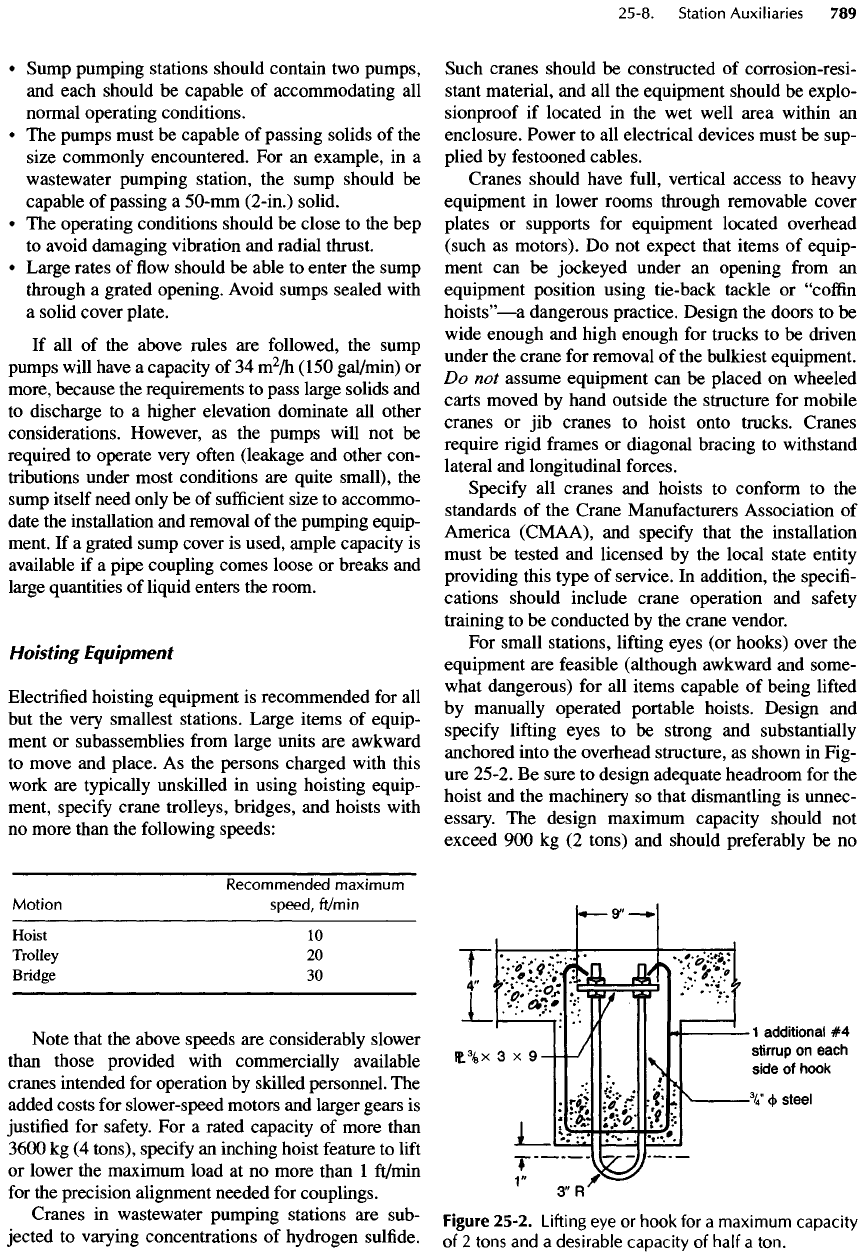
•
Sump pumping stations should contain
two
pumps,
and
each should
be
capable
of
accommodating
all
normal
operating conditions.
• The
pumps must
be
capable
of
passing solids
of the
size commonly encountered.
For an
example,
in a
wastewater pumping station,
the
sump should
be
capable
of
passing
a
50-mm
(2-in.)
solid.
• The
operating conditions should
be
close
to the bep
to
avoid damaging vibration
and
radial thrust.
•
Large rates
of flow
should
be
able
to
enter
the
sump
through
a
grated
opening.
Avoid sumps
sealed
with
a
solid cover plate.
If
all of the
above rules
are
followed,
the
sump
pumps
will have
a
capacity
of 34
m
2
/h
(150
gal/min)
or
more, because
the
requirements
to
pass large
solids
and
to
discharge
to a
higher elevation dominate
all
other
considerations. However,
as the
pumps will
not be
required
to
operate very
often
(leakage
and
other con-
tributions under most conditions
are
quite small),
the
sump
itself need only
be of
sufficient
size
to
accommo-
date
the
installation
and
removal
of the
pumping equip-
ment.
If a
grated sump cover
is
used, ample capacity
is
available
if a
pipe coupling comes
loose
or
breaks
and
large quantities
of
liquid enters
the
room.
Hoisting
Equipment
Electrified
hoisting equipment
is
recommended
for all
but
the
very smallest stations. Large items
of
equip-
ment
or
subassemblies
from
large units
are
awkward
to
move
and
place.
As the
persons charged with this
work
are
typically unskilled
in
using hoisting equip-
ment,
specify
crane trolleys, bridges,
and
hoists
with
no
more than
the
following
speeds:
Recommended
maximum
Motion
speed,
ft/min
Hoist
10
Trolley
20
Bridge
30
Note
that
the
above speeds
are
considerably slower
than
those provided with commercially available
cranes intended
for
operation
by
skilled
personnel.
The
added
costs
for
slower-speed motors
and
larger gears
is
justified
for
safety.
For a
rated capacity
of
more than
3600
kg (4
tons),
specify
an
inching hoist feature
to
lift
or
lower
the
maximum load
at no
more than
1
ft/min
for
the
precision alignment needed
for
couplings.
Cranes
in
wastewater pumping stations
are
sub-
jected
to
varying concentrations
of
hydrogen
sulfide.
Such cranes should
be
constructed
of
corrosion-resi-
stant
material,
and all the
equipment should
be
explo-
sionproof
if
located
in the wet
well area within
an
enclosure. Power
to all
electrical
devices must
be
sup-
plied
by
festooned cables.
Cranes should have
full,
vertical access
to
heavy
equipment
in
lower rooms through removable cover
plates
or
supports
for
equipment
located
overhead
(such
as
motors).
Do not
expect that items
of
equip-
ment
can be
jockeyed under
an
opening
from
an
equipment
position
using
tie-back
tackle
or
"coffin
hoists"
—
a
dangerous practice. Design
the
doors
to be
wide enough
and
high enough
for
trucks
to be
driven
under
the
crane
for
removal
of the
bulkiest equipment.
Do not
assume equipment
can be
placed
on
wheeled
carts moved
by
hand outside
the
structure
for
mobile
cranes
or jib
cranes
to
hoist onto trucks. Cranes
require
rigid
frames
or
diagonal bracing
to
withstand
lateral
and
longitudinal forces.
Specify
all
cranes
and
hoists
to
conform
to the
standards
of the
Crane Manufacturers Association
of
America (CMAA),
and
specify that
the
installation
must
be
tested
and
licensed
by the
local state entity
providing this type
of
service.
In
addition,
the
specifi-
cations
should include crane operation
and
safety
training
to be
conducted
by the
crane vendor.
For
small stations,
lifting
eyes
(or
hooks) over
the
equipment
are
feasible (although awkward
and
some-
what
dangerous)
for all
items capable
of
being
lifted
by
manually operated portable
hoists.
Design
and
specify
lifting
eyes
to be
strong
and
substantially
anchored into
the
overhead structure,
as
shown
in
Fig-
ure
25-2.
Be
sure
to
design adequate headroom
for the
hoist
and the
machinery
so
that dismantling
is
unnec-
essary.
The
design maximum capacity should
not
exceed
900 kg (2
tons)
and
should preferably
be no
Figure
25-2.
Lifting
eye or
hook
for a
maximum
capacity
of
2
tons
and a
desirable
capacity
of
half
a
ton.
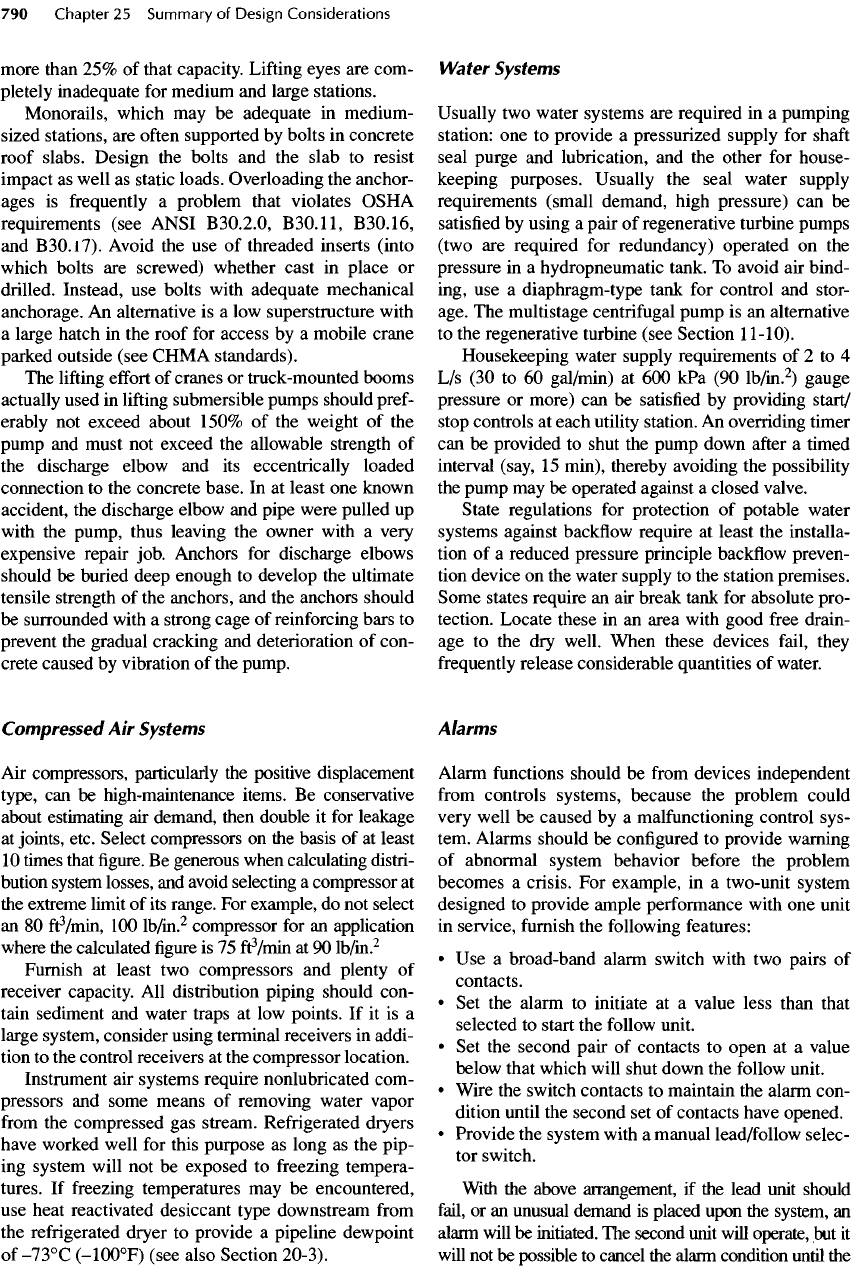
more than
25% of
that capacity.
Lifting
eyes
are
com-
pletely inadequate
for
medium
and
large stations.
Monorails, which
may be
adequate
in
medium-
sized stations,
are
often
supported
by
bolts
in
concrete
roof slabs. Design
the
bolts
and the
slab
to
resist
impact
as
well
as
static
loads.
Overloading
the
anchor-
ages
is
frequently
a
problem that violates OSHA
requirements (see ANSI
B30.2.0,
B30.ll,
B30.16,
and
B30.17).
Avoid
the use of
threaded inserts (into
which
bolts
are
screwed) whether cast
in
place
or
drilled.
Instead,
use
bolts with adequate mechanical
anchorage.
An
alternative
is a low
superstructure with
a
large hatch
in the
roof
for
access
by a
mobile crane
parked outside (see CHMA standards).
The
lifting
effort
of
cranes
or
truck-mounted booms
actually
used
in
lifting
submersible pumps should pref-
erably
not
exceed
about 150%
of the
weight
of the
pump
and
must
not
exceed
the
allowable strength
of
the
discharge elbow
and its
eccentrically loaded
connection
to the
concrete base.
In at
least
one
known
accident,
the
discharge elbow
and
pipe were pulled
up
with
the
pump, thus leaving
the
owner with
a
very
expensive repair job. Anchors
for
discharge elbows
should
be
buried deep enough
to
develop
the
ultimate
tensile strength
of the
anchors,
and the
anchors should
be
surrounded with
a
strong cage
of
reinforcing bars
to
prevent
the
gradual cracking
and
deterioration
of
con-
crete
caused
by
vibration
of the
pump.
Compressed
Air
Systems
Air
compressors, particularly
the
positive displacement
type,
can be
high-maintenance items.
Be
conservative
about
estimating
air
demand, then double
it for
leakage
at
joints, etc. Select compressors
on the
basis
of at
least
10
times
that
figure. Be
generous
when
calculating distri-
bution
system losses,
and
avoid selecting
a
compressor
at
the
extreme limit
of its
range.
For
example,
do not
select
an
80 ft
3
/min, 100
lb/in.
2
compressor
for an
application
where
the
calculated
figure is 75 ft
3
/min at 90
lb/in.
2
Furnish
at
least
two
compressors
and
plenty
of
receiver capacity.
All
distribution piping should con-
tain
sediment
and
water traps
at low
points.
If it is a
large system, consider using terminal receivers
in
addi-
tion
to the
control receivers
at the
compressor location.
Instrument
air
systems require
nonlubricated
com-
pressors
and
some means
of
removing water vapor
from
the
compressed
gas
stream. Refrigerated dryers
have
worked well
for
this purpose
as
long
as the
pip-
ing
system will
not be
exposed
to
freezing
tempera-
tures.
If
freezing
temperatures
may be
encountered,
use
heat reactivated desiccant type downstream
from
the
refrigerated dryer
to
provide
a
pipeline dewpoint
of
-73
0
C
(-10O
0
F)
(see also Section
20-3).
Water
Systems
Usually
two
water systems
are
required
in a
pumping
station:
one to
provide
a
pressurized supply
for
shaft
seal purge
and
lubrication,
and the
other
for
house-
keeping purposes. Usually
the
seal
water supply
requirements (small demand, high pressure)
can be
satisfied
by
using
a
pair
of
regenerative turbine pumps
(two
are
required
for
redundancy) operated
on the
pressure
in a
hydropneumatic tank.
To
avoid
air
bind-
ing,
use a
diaphragm-type tank
for
control
and
stor-
age.
The
multistage
centrifugal
pump
is an
alternative
to
the
regenerative turbine (see Section
11-10).
Housekeeping water supply requirements
of 2 to 4
L/s (30 to 60
gal/min)
at 600
kPa
(90
lb/in.
2
)
gauge
pressure
or
more)
can be
satisfied
by
providing start/
stop controls
at
each utility station.
An
overriding timer
can be
provided
to
shut
the
pump down
after
a
timed
interval (say,
15
min),
thereby avoiding
the
possibility
the
pump
may be
operated against
a
closed valve.
State regulations
for
protection
of
potable water
systems against
backflow
require
at
least
the
installa-
tion
of a
reduced pressure principle
backflow
preven-
tion device
on the
water supply
to the
station premises.
Some states require
an air
break tank
for
absolute pro-
tection. Locate these
in an
area with good
free
drain-
age to the dry
well. When these devices
fail,
they
frequently
release
considerable
quantities
of
water.
Alarms
Alarm
functions
should
be
from
devices independent
from
controls systems, because
the
problem could
very
well
be
caused
by a
malfunctioning control sys-
tem. Alarms should
be
configured
to
provide warning
of
abnormal system behavior before
the
problem
becomes
a
crisis.
For
example,
in a
two-unit system
designed
to
provide ample performance with
one
unit
in
service,
furnish
the
following
features:
• Use a
broad-band alarm switch with
two
pairs
of
contacts.
• Set the
alarm
to
initiate
at a
value less than that
selected
to
start
the
follow
unit.
• Set the
second pair
of
contacts
to
open
at a
value
below that which will shut down
the
follow
unit.
•
Wire
the
switch contacts
to
maintain
the
alarm con-
dition until
the
second
set of
contacts have opened.
•
Provide
the
system with
a
manual lead/follow
selec-
tor
switch.
With
the
above arrangement,
if the
lead
unit
should
fail,
or an
unusual demand
is
placed upon
the
system,
an
alarm
will
be
initiated.
The
second unit will operate,
but it
will
not be
possible
to
cancel
the
alarm condition until
the
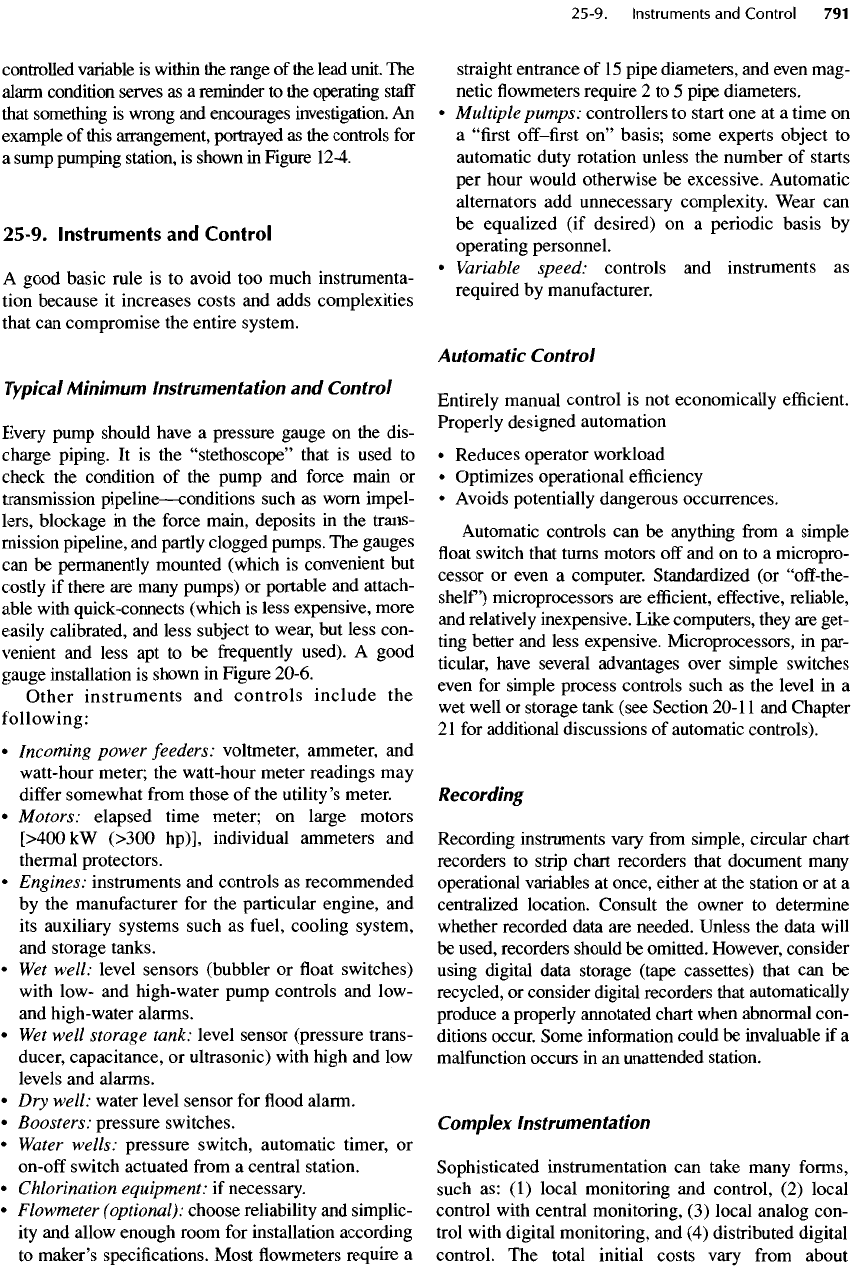
controlled variable
is
within
the
range
of the
lead unit.
The
alarm
condition serves
as a
reminder
to the
operating
staff
that
something
is
wrong
and
encourages investigation.
An
example
of
this arrangement, portrayed
as the
controls
for
a
sump pumping station,
is
shown
in
Figure 12-4.
25-9.
Instruments
and
Control
A
good basic rule
is to
avoid
too
much instrumenta-
tion because
it
increases costs
and
adds complexities
that
can
compromise
the
entire system.
Typical
Minimum Instrumentation
and
Control
Every
pump should have
a
pressure gauge
on the
dis-
charge
piping.
It is the
"stethoscope"
that
is
used
to
check
the
condition
of the
pump
and
force main
or
transmission
pipeline
—
conditions
such
as
worn impel-
lers, blockage
in the
force main, deposits
in the
trans-
mission pipeline,
and
partly clogged pumps.
The
gauges
can
be
permanently mounted (which
is
convenient
but
costly
if
there
are
many pumps)
or
portable
and
attach-
able
with quick-connects (which
is
less expensive, more
easily
calibrated,
and
less subject
to
wear,
but
less con-
venient
and
less
apt to be
frequently
used).
A
good
gauge
installation
is
shown
in
Figure 20-6.
Other instruments
and
controls include
the
following:
•
Incoming power
feeders:
voltmeter, ammeter,
and
watt-hour
meter;
the
watt-hour meter readings
may
differ
somewhat
from
those
of the
utility's meter.
•
Motors: elapsed time meter;
on
large motors
[>400kW
(>300
hp)], individual ammeters
and
thermal
protectors.
•
Engines: instruments
and
controls
as
recommended
by
the
manufacturer
for the
particular engine,
and
its
auxiliary systems such
as
fuel,
cooling system,
and
storage tanks.
• Wet
well: level sensors (bubbler
or float
switches)
with
low-
and
high-water pump controls
and
low-
and
high-
water
alarms.
• Wet
well storage tank: level sensor (pressure trans-
ducer,
capacitance,
or
ultrasonic) with high
and low
levels
and
alarms.
• Dry
well: water level sensor
for flood
alarm.
•
Boosters: pressure switches.
•
Water
wells: pressure switch, automatic timer,
or
on-off
switch actuated
from
a
central station.
•
Chlorination equipment:
if
necessary.
•
Flowmeter
(optional):
choose reliability
and
simplic-
ity
and
allow enough room
for
installation according
to
maker's specifications. Most
flowmeters
require
a
straight entrance
of 15
pipe diameters,
and
even mag-
netic
flowmeters
require
2 to 5
pipe
diameters.
•
Multiple
pumps: controllers
to
start
one at a
time
on
a
"first
off-first
on"
basis; some experts object
to
automatic duty rotation unless
the
number
of
starts
per
hour would otherwise
be
excessive. Automatic
alternators
add
unnecessary complexity. Wear
can
be
equalized
(if
desired)
on a
periodic basis
by
operating personnel.
•
Variable
speed: controls
and
instruments
as
required
by
manufacturer.
Automatic
Control
Entirely manual control
is not
economically
efficient.
Properly designed automation
•
Reduces operator workload
•
Optimizes operational
efficiency
•
Avoids potentially dangerous occurrences.
Automatic
controls
can be
anything
from a
simple
float
switch
that turns motors
off and on to a
micropro-
cessor
or
even
a
computer. Standardized
(or
"off-the-
shelf)
microprocessors
are
efficient,
effective,
reliable,
and
relatively inexpensive. Like computers, they
are
get-
ting
better
and
less expensive. Microprocessors,
in
par-
ticular,
have several advantages over simple switches
even for
simple process controls such
as the
level
in a
wet
well
or
storage tank (see Section
20-1
1
and
Chapter
21 for
additional discussions
of
automatic controls).
Recording
Recording instruments vary
from
simple, circular chart
recorders
to
strip chart recorders that document many
operational variables
at
once, either
at the
station
or at a
centralized location. Consult
the
owner
to
determine
whether recorded data
are
needed. Unless
the
data will
be
used, recorders should
be
omitted. However, consider
using digital data storage (tape cassettes) that
can be
recycled,
or
consider digital recorders that automatically
produce
a
properly annotated chart when abnormal con-
ditions occur. Some information could
be
invaluable
if a
malfunction
occurs
in an
unattended station.
Complex
Instrumentation
Sophisticated instrumentation
can
take many forms,
such
as: (1)
local monitoring
and
control,
(2)
local
control with central monitoring,
(3)
local analog con-
trol with digital monitoring,
and (4)
distributed digital
control.
The
total initial costs vary
from
about
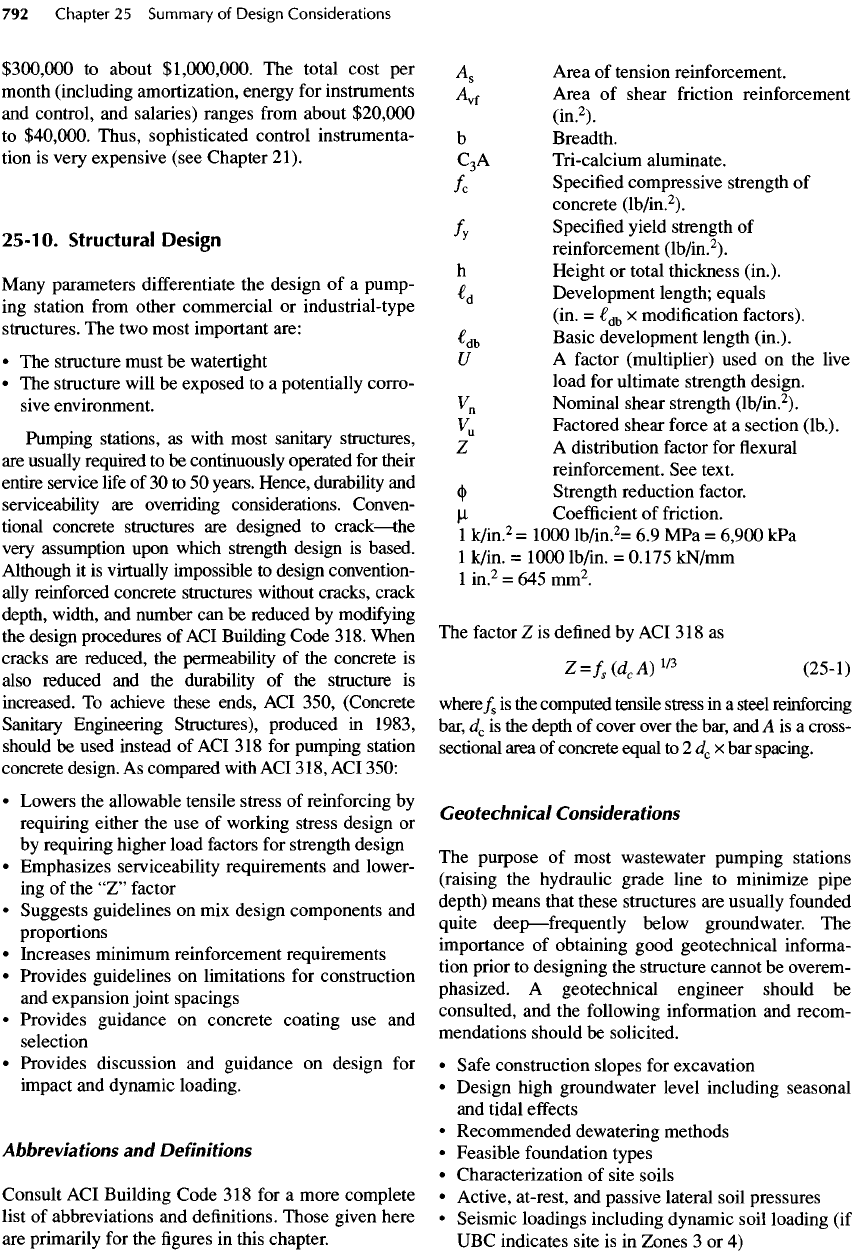
$300,000
to
about
$1,000,000.
The
total
cost
per
month
(including amortization, energy
for
instruments
and
control,
and
salaries) ranges
from
about
$20,000
to
$40,000.
Thus, sophisticated control instrumenta-
tion
is
very expensive (see Chapter 21).
25-10.
Structural
Design
Many
parameters
differentiate
the
design
of a
pump-
ing
station
from
other commercial
or
industrial-type
structures.
The two
most important are:
• The
structure must
be
watertight
• The
structure will
be
exposed
to a
potentially corro-
sive
environment.
Pumping
stations,
as
with
most sanitary structures,
are
usually required
to be
continuously operated
for
their
entire service
life
of 30 to 50
years. Hence, durability
and
serviceability
are
overriding considerations. Conven-
tional concrete structures
are
designed
to
crack
—
the
very
assumption upon which strength design
is
based.
Although
it is
virtually impossible
to
design convention-
ally
reinforced concrete structures without cracks, crack
depth, width,
and
number
can be
reduced
by
modifying
the
design procedures
of ACI
Building Code
318.
When
cracks
are
reduced,
the
permeability
of the
concrete
is
also reduced
and the
durability
of the
structure
is
increased.
To
achieve these ends,
ACI
350, (Concrete
Sanitary
Engineering Structures), produced
in
1983,
should
be
used instead
of ACI
318
for
pumping station
concrete design.
As
compared with
ACI
318,
ACI
350:
•
Lowers
the
allowable tensile stress
of
reinforcing
by
requiring either
the use of
working stress design
or
by
requiring higher load
factors
for
strength design
•
Emphasizes serviceability requirements
and
lower-
ing
of the "Z"
factor
•
Suggests guidelines
on mix
design components
and
proportions
•
Increases minimum reinforcement requirements
•
Provides guidelines
on
limitations
for
construction
and
expansion joint spacings
•
Provides guidance
on
concrete coating
use and
selection
•
Provides discussion
and
guidance
on
design
for
impact
and
dynamic loading.
Abbreviations
and
Definitions
Consult
ACI
Building Code
318
for a
more complete
list
of
abbreviations
and
definitions.
Those
given here
are
primarily
for the figures in
this chapter.
A
8
Area
of
tension reinforcement.
A
vf
Area
of
shear
friction
reinforcement
(in.
2
),
b
Breadth.
C
3
A
Tri-calcium
aluminate.
/
c
Specified
compressive
strength
of
concrete
(lb/in.
2
).
/
y
Specified yield strength
of
reinforcement
(lb/in.
2
).
h
Height
or
total thickness
(in.).
€
d
Development length; equals
(in.
=
€
db
x
modification factors).
€
db
Basic development length
(in.).
U
A
factor (multiplier) used
on the
live
load
for
ultimate strength design.
V
n
Nominal shear strength
(lb/in.
2
).
V
u
Factored
shear
force
at a
section
(Ib.).
Z A
distribution
factor
for flexural
reinforcement.
See
text.
(|)
Strength reduction factor.
Ji
Coefficient
of
friction.
1
k/in.
2
=
1000
lb/in.
2
=
6.9 MPa =
6,900
kPa
1
k/in.
=
1000 lb/in.
=
0.175
kN/mm
1
in.
2
= 645
mm
2
.
The
factor
Z is
defined
by ACI
3
18
as
Z=J
5
(^A)
1
/
3
(25-1)
where/
s
is the
computed tensile stress
in a
steel reinforcing
bar,
d
c
is the
depth
of
cover over
the
bar,
and A is a
cross-
sectional area
of
concrete equal
to 2
d
c
x bar
spacing.
Geotechnical
Considerations
The
purpose
of
most wastewater pumping stations
(raising
the
hydraulic grade line
to
minimize pipe
depth) means that these structures
are
usually
founded
quite
deep
—
frequently
below groundwater.
The
importance
of
obtaining good
geotechnical
informa-
tion prior
to
designing
the
structure cannot
be
overem-
phasized.
A
geotechnical engineer should
be
consulted,
and the
following information
and
recom-
mendations should
be
solicited.
•
Safe
construction slopes
for
excavation
•
Design high groundwater level including seasonal
and
tidal
effects
•
Recommended
dewatering
methods
•
Feasible
foundation types
•
Characterization
of
site soils
•
Active, at-rest,
and
passive lateral soil pressures
•
Seismic loadings including dynamic soil loading
(if
UBC
indicates site
is in
Zones
3 or 4)
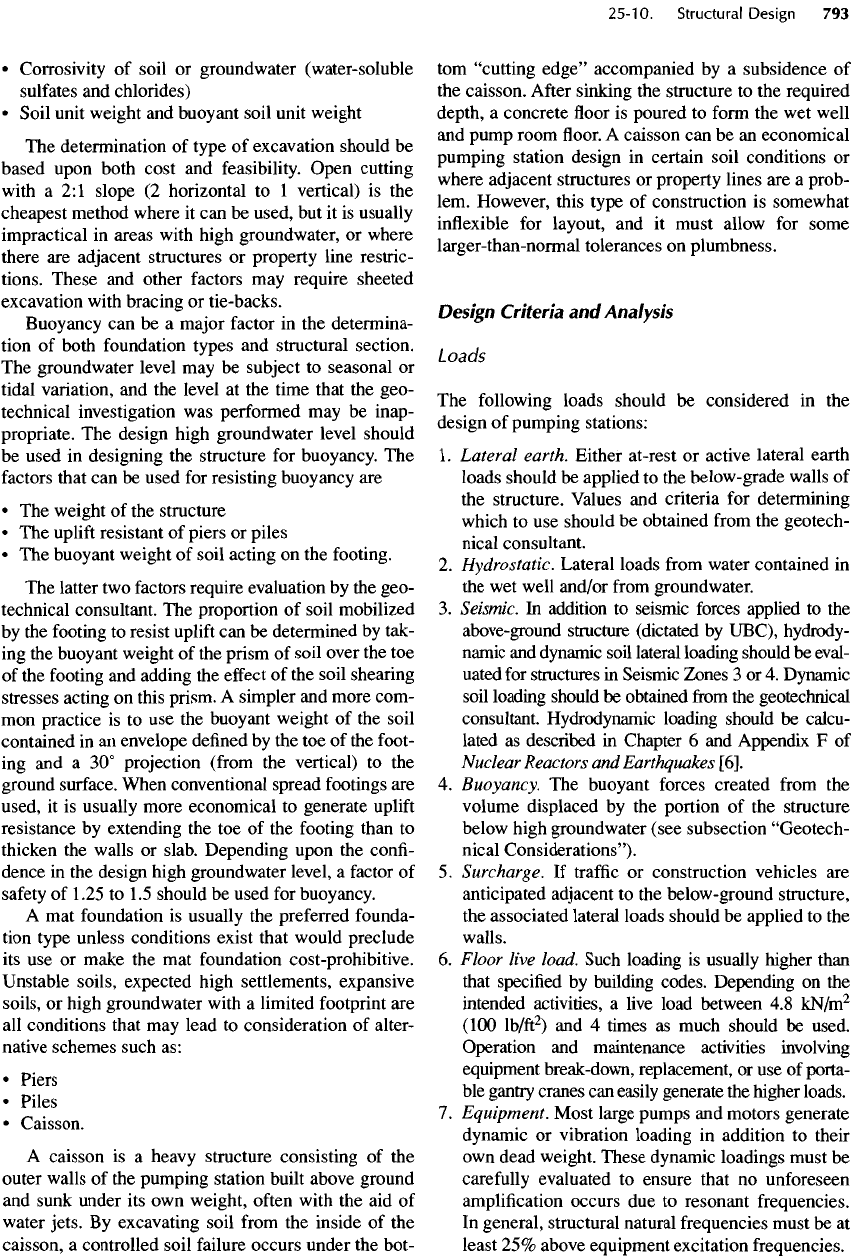
•
Corrosivity
of
soil
or
groundwater (water-soluble
sulfates
and
chlorides)
•
Soil
unit weight
and
buoyant soil unit weight
The
determination
of
type
of
excavation should
be
based upon both cost
and
feasibility. Open cutting
with
a
2:1
slope
(2
horizontal
to 1
vertical)
is the
cheapest method where
it can be
used,
but it is
usually
impractical
in
areas with high groundwater,
or
where
there
are
adjacent structures
or
property
line
restric-
tions. These
and
other factors
may
require sheeted
excavation with bracing
or
tie-backs.
Buoyancy
can be a
major factor
in the
determina-
tion
of
both foundation types
and
structural section.
The
groundwater level
may be
subject
to
seasonal
or
tidal
variation,
and the
level
at the
time that
the
geo-
technical investigation
was
performed
may be
inap-
propriate.
The
design high groundwater level should
be
used
in
designing
the
structure
for
buoyancy.
The
factors
that
can be
used
for
resisting buoyancy
are
• The
weight
of the
structure
• The
uplift
resistant
of
piers
or
piles
• The
buoyant weight
of
soil acting
on the
footing.
The
latter
two
factors require evaluation
by the
geo-
technical consultant.
The
proportion
of
soil mobilized
by
the
footing
to
resist
uplift
can be
determined
by
tak-
ing
the
buoyant weight
of the
prism
of
soil over
the toe
of
the
footing
and
adding
the
effect
of the
soil shearing
stresses acting
on
this prism.
A
simpler
and
more com-
mon
practice
is to use the
buoyant weight
of the
soil
contained
in an
envelope
defined
by the toe of the
foot-
ing and a 30°
projection
(from
the
vertical)
to the
ground
surface. When conventional spread footings
are
used,
it is
usually more
economical
to
generate
uplift
resistance
by
extending
the toe of the
footing than
to
thicken
the
walls
or
slab. Depending upon
the
confi-
dence
in the
design high groundwater level,
a
factor
of
safety
of
1.25
to 1.5
should
be
used
for
buoyancy.
A mat
foundation
is
usually
the
preferred founda-
tion
type unless conditions exist that would preclude
its
use or
make
the mat
foundation cost-prohibitive.
Unstable soils, expected high settlements, expansive
soils,
or
high groundwater with
a
limited footprint
are
all
conditions that
may
lead
to
consideration
of
alter-
native schemes such
as:
•
Piers
•
Piles
•
Caisson.
A
caisson
is a
heavy structure consisting
of the
outer
walls
of the
pumping station built above ground
and
sunk under
its own
weight,
often
with
the aid of
water
jets.
By
excavating
soil
from
the
inside
of the
caisson,
a
controlled soil failure occurs under
the
bot-
tom
"cutting
edge"
accompanied
by a
subsidence
of
the
caisson.
After
sinking
the
structure
to the
required
depth,
a
concrete
floor is
poured
to
form
the wet
well
and
pump room
floor. A
caisson
can be an
economical
pumping station design
in
certain
soil
conditions
or
where adjacent structures
or
property lines
are a
prob-
lem. However, this type
of
construction
is
somewhat
inflexible
for
layout,
and it
must allow
for
some
larger-than-normal
tolerances
on
plumbness.
Design
Criteria
and
Analysis
Loads
The
following loads should
be
considered
in the
design
of
pumping stations:
1.
Lateral earth. Either at-rest
or
active lateral earth
loads should
be
applied
to the
below-grade
walls
of
the
structure. Values
and
criteria
for
determining
which
to use
should
be
obtained
from
the
geotech-
nical
consultant.
2.
Hydrostatic. Lateral loads
from
water
contained
in
the wet
well and/or
from
groundwater.
3.
Seismic.
In
addition
to
seismic forces applied
to the
above-ground
structure (dictated
by
UBC), hydrody-
namic
and
dynamic soil lateral loading should
be
eval-
uated
for
structures
in
Seismic Zones
3 or 4.
Dynamic
soil loading should
be
obtained
from the
geotechnical
consultant.
Hydrodynamic
loading should
be
calcu-
lated
as
described
in
Chapter
6 and
Appendix
F of
Nuclear
Reactors
and
Earthquakes
[6].
4.
Buoyancy.
The
buoyant forces created
from
the
volume
displaced
by the
portion
of the
structure
below high groundwater (see subsection
"Geotech-
nical Considerations").
5.
Surcharge.
If
traffic
or
construction vehicles
are
anticipated adjacent
to the
below-ground structure,
the
associated
lateral loads should
be
applied
to the
walls.
6.
Floor
live
load.
Such loading
is
usually higher than
that
specified
by
building codes. Depending
on the
intended activities,
a
live load between
4.8
kN/m
2
(100
lb/ft
2
)
and 4
times
as
much should
be
used.
Operation
and
maintenance activities involving
equipment break-down, replacement,
or use of
porta-
ble
gantry cranes
can
easily generate
the
higher loads.
7.
Equipment. Most large pumps
and
motors generate
dynamic
or
vibration loading
in
addition
to
their
own
dead weight.
These
dynamic loadings must
be
carefully
evaluated
to
ensure that
no
unforeseen
amplification
occurs
due to
resonant frequencies.
In
general, structural natural frequencies must
be at
least
25%
above equipment excitation frequencies.
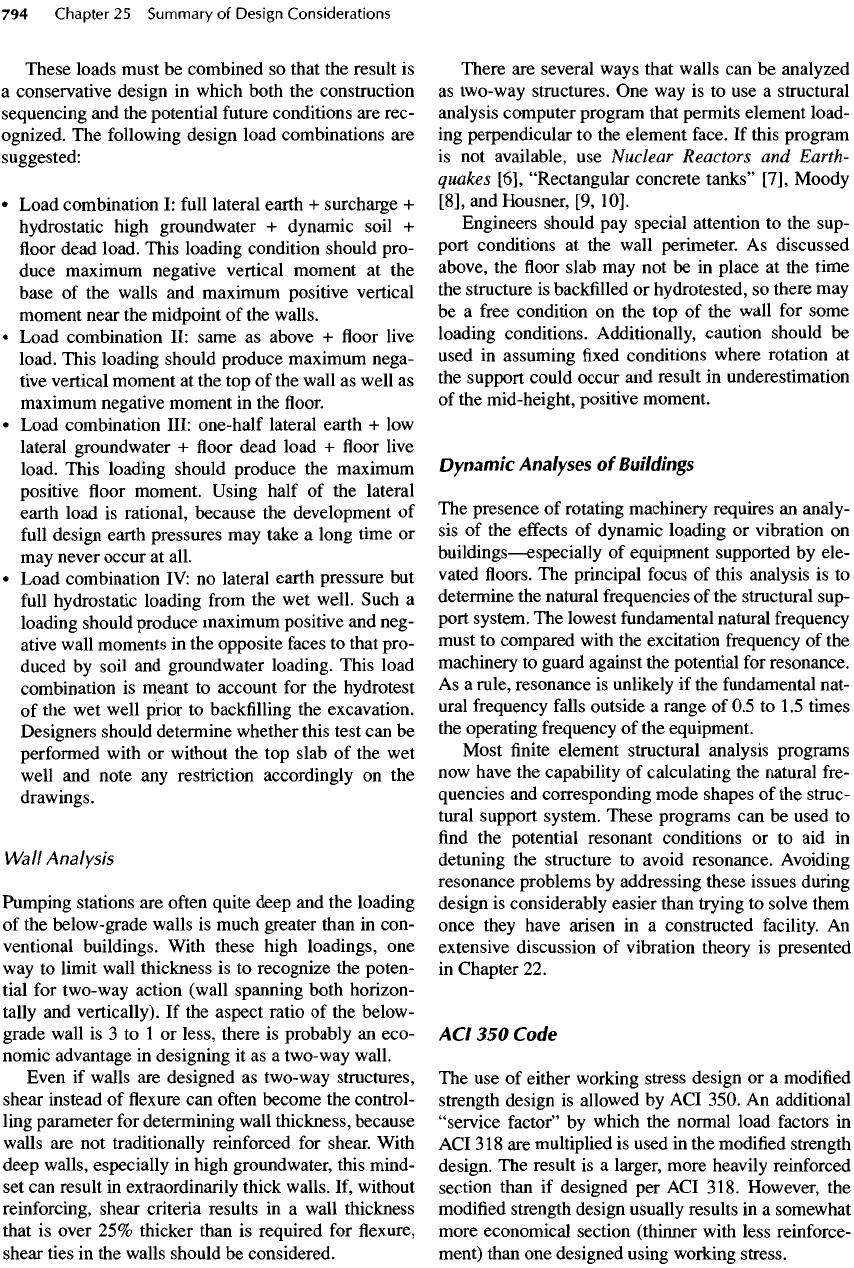
These loads must
be
combined
so
that
the
result
is
a
conservative design
in
which both
the
construction
sequencing
and the
potential
future
conditions
are
rec-
ognized.
The
following
design load combinations
are
suggested:
•
Load combination
I:
full
lateral earth
+
surcharge
+
hydrostatic high groundwater
+
dynamic soil
+
floor
dead load. This loading condition should pro-
duce
maximum negative vertical moment
at the
base
of the
walls
and
maximum positive vertical
moment near
the
midpoint
of the
walls.
•
Load combination
II:
same
as
above
+ floor
live
load. This loading should produce maximum nega-
tive vertical moment
at the top of the
wall
as
well
as
maximum
negative moment
in the floor.
•
Load combination III: one-half lateral earth
+ low
lateral groundwater
+ floor
dead load
+ floor
live
load.
This loading should produce
the
maximum
positive
floor
moment. Using half
of the
lateral
earth load
is
rational, because
the
development
of
full
design earth pressures
may
take
a
long time
or
may
never occur
at
all.
•
Load combination
IV: no
lateral earth pressure
but
full
hydrostatic loading
from
the wet
well. Such
a
loading should produce maximum positive
and
neg-
ative
wall moments
in the
opposite
faces
to
that pro-
duced
by
soil
and
groundwater loading. This load
combination
is
meant
to
account
for the
hydrotest
of
the wet
well prior
to
backfilling
the
excavation.
Designers should determine whether this test
can be
performed
with
or
without
the top
slab
of the wet
well
and
note
any
restriction accordingly
on the
drawings.
Wall
Analysis
Pumping stations
are
often
quite deep
and the
loading
of
the
below-grade
walls
is
much greater than
in
con-
ventional buildings. With these high loadings,
one
way
to
limit wall thickness
is to
recognize
the
poten-
tial
for
two-way action (wall spanning both horizon-
tally
and
vertically).
If the
aspect ratio
of the
below-
grade wall
is 3 to 1 or
less, there
is
probably
an
eco-
nomic advantage
in
designing
it as a
two-way wall.
Even
if
walls
are
designed
as
two-way structures,
shear instead
of flexure can
often
become
the
control-
ling
parameter
for
determining wall thickness, because
walls
are not
traditionally reinforced
for
shear. With
deep walls, especially
in
high groundwater, this mind-
set can
result
in
extraordinarily thick walls.
If,
without
reinforcing, shear
criteria
results
in a
wall thickness
that
is
over
25%
thicker than
is
required
for flexure,
shear ties
in the
walls should
be
considered.
There
are
several ways that walls
can be
analyzed
as
two-way structures.
One way is to use a
structural
analysis computer program that permits element load-
ing
perpendicular
to the
element
face.
If
this program
is not
available,
use
Nuclear Reactors
and
Earth-
quakes
[6], "Rectangular concrete
tanks"
[7], Moody
[8],
and
Housner,
[9,
1O].
Engineers should
pay
special
attention
to the
sup-
port
conditions
at the
wall
perimeter.
As
discussed
above,
the floor
slab
may not be in
place
at the
time
the
structure
is
backfilled
or
hydrotested,
so
there
may
be a
free
condition
on the top of the
wall
for
some
loading conditions. Additionally, caution should
be
used
in
assuming
fixed
conditions where rotation
at
the
support could occur
and
result
in
underestimation
of
the
mid-height, positive moment.
Dynamic
Analyses
of
Buildings
The
presence
of
rotating machinery requires
an
analy-
sis of the
effects
of
dynamic loading
or
vibration
on
buildings
—
especially
of
equipment supported
by
ele-
vated
floors. The
principal
focus
of
this analysis
is to
determine
the
natural frequencies
of the
structural sup-
port system.
The
lowest
fundamental
natural
frequency
must
to
compared with
the
excitation
frequency
of the
machinery
to
guard against
the
potential
for
resonance.
As a
rule, resonance
is
unlikely
if the
fundamental
nat-
ural
frequency
falls
outside
a
range
of 0.5 to 1.5
times
the
operating
frequency
of the
equipment.
Most
finite
element structural analysis programs
now
have
the
capability
of
calculating
the
natural fre-
quencies
and
corresponding
mode shapes
of the
struc-
tural
support system.
These
programs
can be
used
to
find the
potential resonant conditions
or to aid in
detuning
the
structure
to
avoid resonance. Avoiding
resonance problems
by
addressing these issues during
design
is
considerably easier than trying
to
solve them
once they have arisen
in a
constructed facility.
An
extensive discussion
of
vibration theory
is
presented
in
Chapter
22.
ACI
350
Code
The use of
either working stress design
or a
modified
strength design
is
allowed
by ACI
350.
An
additional
"service
factor"
by
which
the
normal load
factors
in
ACI 318 are
multiplied
is
used
in the
modified
strength
design.
The
result
is a
larger, more heavily reinforced
section than
if
designed
per ACI
318.
However,
the
modified
strength design usually results
in a
somewhat
more economical section (thinner with less reinforce-
ment) than
one
designed using working
stress.

ACI
350
also prescribes
an
additional
12-mm
(V
2
-
in.)
concrete cover over
the
reinforcing steel, because
it
is
recognized that these structures
function
in a
potentially aggressive environment.
Crack control
and
serviceability (receiving greater
attention
in ACI
350)
is
accomplished
by
reducing
the
value
of the
reinforcing distribution factor,
Z,
from
a
maximum
of 25
kN/mm
(145
k/in.)
for
exteriors
to a
maximum
of 20
kN/mm
(115
kips/in.)
for a
normal
sanitary
exposure
—
even
down
to 17
kN/mm
(95
k/in.)
for
severe sanitary exposure.
The
practical
effect
is
that,
for a
given required area
of
steel, smaller reinforc-
ing
bars
at
closer spacing
are
required.
In SI
units,
for
example,
if the
required area
of
steel
in a flexural
sec-
tion
is
37.5
cm
2
/m,
the use of
number
35M
bars
at 265
mm
spacing would
satisfy
the
strength requirement,
but
d
c
is
71
mm, so Z =
22.2,
a
number that exceeds
the
maximum
of 20.
However,
for
number
3OM
bars
at
180
mm
spacing,
d
c
is 68 mm , so Z =
19.0 and, there-
fore,
the
second choice
for
reinforcement satisfies both
provisions.
In
U.S. customary units,
the
required area
of
steel
is
1.78
in.
2
/ft.,
and
although number
10
bars
at
8.5-in. spacing satisfies
the
strength requirement,
d
c
is
2.72
in.,
and Z =
118.4
—
more
than 115. Number
9
bars
at
6.5-in. spacing with
d
c
at
2.62
in.
yield
a Z of
103,
which
satifies
both requirements.
One
other modification
in ACI 350
aimed
at
crack
control
is a
significant
increase
in
minimum temperature
and
shrinkage reinforcing.
In ACI 350 the
minimum
reinforcing
is
correlated
to the
spacing
of
movement
joints
by
allowing less reinforcing where joints
are
spaced more closely.
The
primary
effect
of
this provision
would
occur
in
sections
where
flexure is not a
controlling
parameter.
As
shown
in
Figure 25-3, even with move-
ment
joints
at a 9-m
(30-ft)
spacing,
50%
more reinforc-
ing
steel
is
required than
in
nonhydraulic
structures.
Concrete
Mix
The
concrete
mix
design
for any
hydraulic structure
subject
to the
same environment
as in
pumping sta-
tions should
be
modified over that specified
for
build-
ing
construction. Design 28-day
compressive
strengths should
be
28,000
kPa
(4000
lb/in.
2
)
mini-
mum
for
concrete exposed
to
freezing
and
thawing
cycles
and
24,000
kPa
(3500
lb/in.
2
)
minimum
for
concrete
not
exposed
to
these cycles. Again,
the
goal
of
these modifications
is to
produce
a
more durable
and
watertight structure.
Cement
In
structures exposed
to
wastewater
or
wastewater
effluent,
the
cement should have
a
C
3
A
content
of
less
than
8%.
Where possible, therefore, ASTM
C
150,
Types
II or V
Portland cements should
be
used.
In
some parts
of the
country, requiring Type
II or V
cement
can
significantly
increase
the
concrete
cost.
Substituting
a
pozzolan, ASTM
C618
(fly ash),
for a
portion
of the
cement
so
that
the
total
C
3
A
content
does
not
exceed
5% can
offer
similar sulfate resis-
tance with Type
I
cement.
The
pozzolan should
not
exceed
20% by
weight
of the
cement plus pozzolan.
Engineers should
be
aware that
the use of
Type
V
cement
or the
addition
of fly ash
frequently suppresses
Figure
25-3.
Wall
shrinkage
reinforcement.
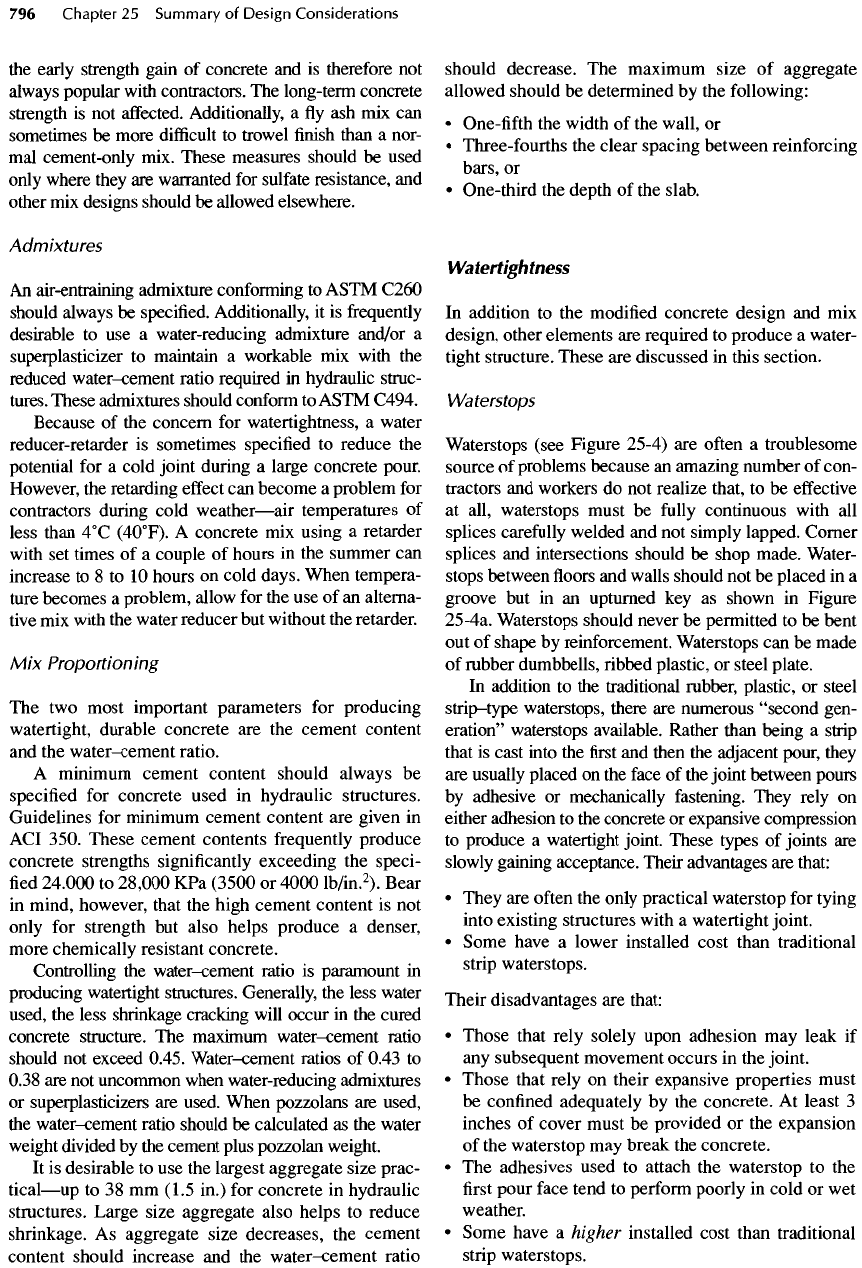
the
early strength gain
of
concrete
and is
therefore
not
always
popular with contractors.
The
long-term concrete
strength
is not
affected.
Additionally,
a fly ash mix can
sometimes
be
more
difficult
to
trowel
finish
than
a
nor-
mal
cement-only mix. These measures should
be
used
only
where they
are
warranted
for
sulfate
resistance,
and
other
mix
designs should
be
allowed elsewhere.
Admixtures
An
air-entraining admixture conforming
to
ASTM C260
should
always
be
specified. Additionally,
it is
frequently
desirable
to use a
water-reducing admixture and/or
a
superplasticizer
to
maintain
a
workable
mix
with
the
reduced
water-cement
ratio required
in
hydraulic struc-
tures.
These admixtures should conform
to
ASTM C494.
Because
of the
concern
for
watertightness,
a
water
reducer-retarder
is
sometimes specified
to
reduce
the
potential
for a
cold joint during
a
large concrete pour.
However,
the
retarding
effect
can
become
a
problem
for
contractors during cold
weather
—
air
temperatures
of
less
than
4
0
C
(4O
0
F).
A
concrete
mix
using
a
retarder
with
set
times
of a
couple
of
hours
in the
summer
can
increase
to 8 to 10
hours
on
cold days. When tempera-
ture becomes
a
problem, allow
for the use of an
alterna-
tive
mix
with
the
water reducer
but
without
the
retarder.
Mix
Proportioning
The two
most important parameters
for
producing
watertight,
durable concrete
are the
cement content
and
the
water-cement
ratio.
A
minimum cement content should always
be
specified
for
concrete used
in
hydraulic structures.
Guidelines
for
minimum cement content
are
given
in
ACI
350. These cement contents
frequently
produce
concrete strengths
significantly
exceeding
the
speci-
fied
24.000
to
28,000
KPa
(3500
or
4000
lb/in.
2
).
Bear
in
mind, however, that
the
high cement content
is not
only
for
strength
but
also helps produce
a
denser,
more chemically resistant concrete.
Controlling
the
water-cement
ratio
is
paramount
in
producing watertight structures. Generally,
the
less water
used,
the
less shrinkage cracking will occur
in the
cured
concrete structure.
The
maximum
water-cement
ratio
should
not
exceed 0.45.
Water-cement
ratios
of
0.43
to
0.38
are not
uncommon when water-reducing admixtures
or
superplasticizers
are
used. When
pozzolans
are
used,
the
water-cement
ratio should
be
calculated
as the
water
weight
divided
by the
cement plus
pozzolan
weight.
It
is
desirable
to use the
largest aggregate size prac-
tical
—
up
to 38 mm
(1.5 in.)
for
concrete
in
hydraulic
structures. Large size aggregate also helps
to
reduce
shrinkage.
As
aggregate size decreases,
the
cement
content should increase
and the
water-cement
ratio
should decrease.
The
maximum size
of
aggregate
allowed should
be
determined
by the
following:
•
One-fifth
the
width
of the
wall,
or
•
Three-fourths
the
clear spacing between reinforcing
bars,
or
•
One-third
the
depth
of the
slab.
Watertightness
In
addition
to the
modified
concrete design
and mix
design, other elements
are
required
to
produce
a
water-
tight structure. These
are
discussed
in
this section.
Waterstops
Waterstops (see Figure 25-4)
are
often
a
troublesome
source
of
problems because
an
amazing number
of
con-
tractors
and
workers
do not
realize that,
to be
effective
at
all, waterstops must
be
fully
continuous with
all
splices
carefully
welded
and not
simply lapped. Corner
splices
and
intersections should
be
shop made. Water-
stops between
floors and
walls should
not be
placed
in a
groove
but in an
upturned
key as
shown
in
Figure
25
-4a.
Waterstops should never
be
permitted
to be
bent
out
of
shape
by
reinforcement. Waterstops
can be
made
of
rubber dumbbells,
ribbed
plastic,
or
steel plate.
In
addition
to the
traditional rubber, plastic,
or
steel
strip—
type
waterstops, there
are
numerous
"second
gen-
eration" waterstops available. Rather than being
a
strip
that
is
cast into
the first and
then
the
adjacent pour, they
are
usually placed
on the
face
of the
joint between pours
by
adhesive
or
mechanically fastening. They rely
on
either adhesion
to the
concrete
or
expansive compression
to
produce
a
watertight joint. These types
of
joints
are
slowly
gaining acceptance. Their advantages
are
that:
•
They
are
often
the
only practical waterstop
for
tying
into existing structures with
a
watertight joint.
•
Some have
a
lower installed cost than traditional
strip waterstops.
Their disadvantages
are
that:
•
Those
that rely solely upon adhesion
may
leak
if
any
subsequent movement occurs
in the
joint.
•
Those that rely
on
their expansive properties must
be
confined
adequately
by the
concrete.
At
least
3
inches
of
cover must
be
provided
or the
expansion
of
the
waterstop
may
break
the
concrete.
• The
adhesives used
to
attach
the
waterstop
to the
first
pour
face
tend
to
perform poorly
in
cold
or wet
weather.
•
Some have
a
higher installed cost than traditional
strip waterstops.
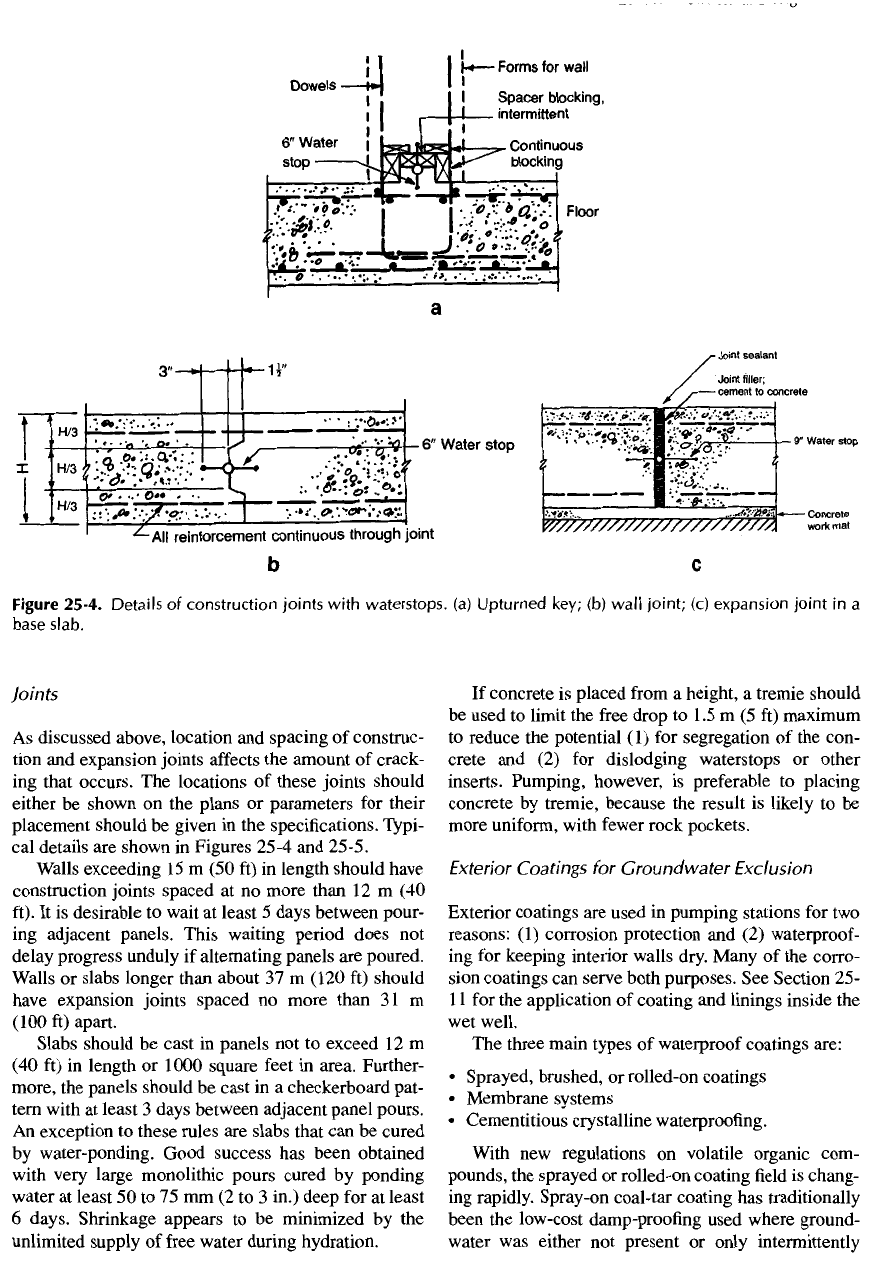
Joints
As
discussed above, location
and
spacing
of
construc-
tion
and
expansion joints
affects
the
amount
of
crack-
ing
that occurs.
The
locations
of
these joints should
either
be
shown
on the
plans
or
parameters
for
their
placement
should
be
given
in the
specifications. Typi-
cal
details
are
shown
in
Figures 25-4
and
25-5.
Walls
exceeding
15 m (50 ft) in
length should have
construction joints spaced
at no
more than
12 m (40
ft).
It is
desirable
to
wait
at
least
5
days between pour-
ing
adjacent panels. This waiting period does
not
delay progress unduly
if
alternating panels
are
poured.
Walls
or
slabs longer than about
37 m
(120
ft)
should
have
expansion joints spaced
no
more than
31 m
(100
ft)
apart.
Slabs should
be
cast
in
panels
not to
exceed
12 m
(40 ft) in
length
or
1000 square
feet
in
area. Further-
more,
the
panels should
be
cast
in a
checkerboard pat-
tern with
at
least
3
days between adjacent panel pours.
An
exception
to
these rules
are
slabs that
can be
cured
by
water-ponding. Good success
has
been obtained
with
very large monolithic pours cured
by
ponding
water
at
least
50 to 75 mm (2 to 3
in.) deep
for at
least
6
days. Shrinkage appears
to be
minimized
by the
unlimited supply
of
free
water during
hydration.
If
concrete
is
placed
from
a
height,
a
tremie should
be
used
to
limit
the
free
drop
to 1.5 m (5 ft)
maximum
to
reduce
the
potential
(1) for
segregation
of the
con-
crete
and (2) for
dislodging waterstops
or
other
inserts. Pumping, however,
is
preferable
to
placing
concrete
by
tremie, because
the
result
is
likely
to be
more uniform, with
fewer
rock pockets.
Exterior
Coatings
for
Groundwater Exclusion
Exterior coatings
are
used
in
pumping stations
for two
reasons:
(1)
corrosion protection
and (2)
waterproof-
ing for
keeping interior walls dry. Many
of the
corro-
sion coatings
can
serve both purposes.
See
Section
25-
1 1
for the
application
of
coating
and
linings inside
the
wet
well.
The
three
main types
of
waterproof coatings are:
•
Sprayed, brushed,
or
rolled-on
coatings
•
Membrane systems
•
Cementitious crystalline waterproofing.
With
new
regulations
on
volatile organic com-
pounds,
the
sprayed
or
rolled-on coating
field is
chang-
ing
rapidly. Spray-on coal-tar coating
has
traditionally
been
the
low-cost damp-proofing used where ground-
water
was
either
not
present
or
only
intermittently
Figure 25-4.
Details
of
construction
joints
with
waterstops.
(a)
Upturned
key;
(b)
wall
joint;
(c)
expansion
joint
in a
base
slab.

present.
The new
higher-solids epoxies that have taken
their place
are of
higher quality
at
higher cost. Unless
there
is a
potential
for
corrosion, other methods
for
waterproofing
are
desirable.
Cementitious
crystalline waterproofing
is
sprayed
or
brushed onto
new
concrete prior
to
complete cur-
ing.
It
reacts with
free
water
and
forms
a
crystalline
matrix
that seals
the
pores
and
capillaries
of the
con-
crete. These systems perform quite well
in
most con-
ditions
at
relatively
low
cost.
Membrane
systems consist
of
sheets
or
panels
that
are
applied
to the
concrete surface
to act as an
impermeable
barrier
for
ground water. Some systems
actually
employ clay panels that swell with contact
to
water providing
an
impermeable barrier.
In
gen-
eral,
membrane systems
are
more expensive
but
more
effective
than crystalline waterproofing.
Details
This section contains miscellaneous aspects
of
details
common
to
pumping stations.
As
with
any
facet
of
structural
design, there
are
many variations
of
these
Figure 25-5.
Concrete
joint
details,
(a)
Shear
friction
joint;
(b)
horizontal
corner
bars
for
walls;
V
u
<
0
V
R
<
0.2
/^A
0
<
800
A
c
;
<|>
=
0.85
for
shear
and
tension;
V
n
=
A^f
y
\i;
\L
=
1.0
for
rough
surfaces.
